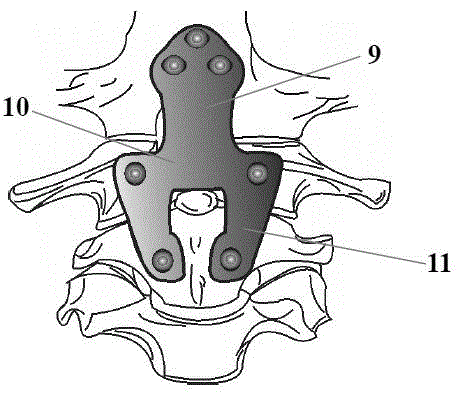Anterior cervical and craniocervical fixing device
A fixation device, anterior approach technology, applied in the direction of fixator, internal fixator, internal bone synthesis, etc., to achieve the effect of reducing operation time, reducing operation risk, and improving stability
- Summary
- Abstract
- Description
- Claims
- Application Information
AI Technical Summary
Problems solved by technology
Method used
Image
Examples
Embodiment 1
[0023] Embodiment 1: Anterior cervical craniocervical fixation device according to the present invention
[0024] Anterior craniocervical fixation device of the present invention, such as figure 1 and figure 2 As shown, it includes: a section of inclined slope fixing section 9 and a section of horizontal atlas fixing section 10; and an axis fixing section 11 extending downward from both sides of the atlas fixing section. The slope fixing part 9 and the atlas fixing part 10 form a certain angle so that the slope fixing part is suitable to be close to the anterior slope of the human neck and the axis vertebrae fixing part is suitable to be close to the human cervical 2 vertebral body. Preferably, the angle between the slope fixing part 9 and the atlas fixing part 10 is 114° to 148°.
[0025] Such as figure 1 As shown, three screw holes 1, 2 and 3 are arranged on the slope fixing part 9, and these screw holes are arranged in a triangle, so that the screws can pass through the...
Embodiment 2
[0035] Embodiment 2: The improved anterior cervical craniocervical fixation device according to the present invention
[0036] The improved anterior cervical craniocervical fixation device of the present invention, such as Figure 5 and Figure 6 As shown, it includes: a section of inclined slope fixation part 9 and a section of horizontal atlas fixation part 10; and an axis fixation part 11 extending downward from the atlas fixation part. The slope fixing part 9 and the atlas fixing part 10 form a certain angle so that the slope fixing part is suitable for being close to the anterior slope of the human neck, and the axis vertebra fixing part is suitable for being close to the human cervical 2 vertebral body. When the atlas fixation part 10 is extended to form the axis fixation part 11, an open groove 12 is opened in the center, so that after being fixed by the improved anterior cervical craniocervical fixation device, the rear joint space can be passed through the groove. P...
Embodiment 3
[0048] Example 3: Biomechanical Evaluation of the Stability of the Anterior Cervical Craniocervical Fixation Device
[0049] 1. Experimental purpose
[0050] From the perspective of biomechanics, the stability of the anterior craniocervical fixation device of the present invention for upper cervical spine fixation is discussed.
[0051] 2. Experimental materials
[0052] Anterior craniocervical fixation device: it is made of a steel plate, and its structure is referred to in Example 1, hereinafter referred to as "anterior craniocervical fixation plate".
[0053] The occipital-cervical fixation device, hereinafter referred to as "posterior occipital-cervical fixation device", is different from "anterior craniocervical fixation plate".
[0054] Kirschner wire.
[0055] Screws (3.5mm diameter).
[0056] Six cadaveric head and neck specimens (from occipital condyle C0 to C3 vertebrae, 4 males, 2 females; mean age, 46 years; range 35–62 years).
[0057] 3. Experimental method ...
PUM
| Property | Measurement | Unit |
|---|---|---|
| Diameter | aaaaa | aaaaa |
| Diameter | aaaaa | aaaaa |
Abstract
Description
Claims
Application Information
 Login to View More
Login to View More - R&D
- Intellectual Property
- Life Sciences
- Materials
- Tech Scout
- Unparalleled Data Quality
- Higher Quality Content
- 60% Fewer Hallucinations
Browse by: Latest US Patents, China's latest patents, Technical Efficacy Thesaurus, Application Domain, Technology Topic, Popular Technical Reports.
© 2025 PatSnap. All rights reserved.Legal|Privacy policy|Modern Slavery Act Transparency Statement|Sitemap|About US| Contact US: help@patsnap.com



